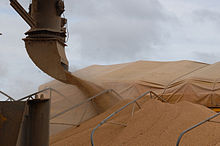Soy meal
Soybean meal is produced in soybean oil production by crushing soybeans . The use of untreated soy meal in food is very low. If soy meal is to be used in animal fattening , it is degreased and heated beforehand. The high content of soybean oil (20% and more) is obtained for the most part by pressing and / or extraction (see below) using hexane. The remaining soy meal is used for animal feeding because it has a very high protein content.
Manufacturing
| 1000 g fresh mass of ... contains | ||
|---|---|---|
| Soy 44 | HP Soy (48) | |
| Crude fiber (XF) | 60 g | 35 g |
| Dry matter (TM) | 880 g | 880 g |
| Crude protein (XP) | 440 g | 480 g |
| Usable Crude Protein (nXP) | 256 g | 270 g |
| Ruminal nitrogen balance (RNB) | 29 g | 34 g |
| Net Energy Lactation (NEL) | 7.61 MJ | 7.72 MJ |
| Convertible Energy (ME) | 12.11 MJ | 12.28 MJ |
| Starch and Sugar (XS + XZ) | 157 g | 162 g |
| constant strength (bXS) | 12 g | 12 g |
| Raw fat (XL) | 12 g | 12 g |
| Rumen Resistant Protein (UDP) | 30% | 30% |
| Structure value (SW) | 0.23 | 0.19 |
| Calcium (Ca) | 2.7 g | 2.8 g |
| Phosphorus (P) | 6.2 g | 6.7 g |
| Magnesium (Mg) | 2.6 g | 2.4 g |
| Sodium (Na) | 0.2 g | 0.3 g |
| Potassium (K) | 19 g | 20 g |
| Lysine | 26.4 g | |
Soy meal is extracted in conjunction with soy oil. First, the soybeans are cleaned, then peeled and mechanically chopped. The oil is extracted from the beans with the help of hexane . After extraction, the soy meal is steam-heated, also called toasting . The hexane is removed by introducing steam and adding heat. Toasting destroys the trypsin inhibitors , which inhibit protein digestion, and hemagglutinins , which can disrupt animal growth. The toasted soy meal is dried and cooled. Coarse lumps of meal are ground up. Various by-products of oil extraction are added to the soy meal. In addition to auxiliary materials, these also include free fatty acids and fuller's earth.
The soy cake , also known as okara , which is related to soy meal , is made during cold pressing when no solvents are used for oil extraction.
use
To a small extent it is used in the human diet as a protein-rich food, e.g. B. for the production of textured soy .
The meal is used as feed for poultry , cattle and pigs . It is also used in feed for pets (especially dogs ) and aquaculture .
Soy meal in cattle feeding
Soy extraction meal is used as a source of protein in cattle feed, making it a substitute for rapeseed meal (RES), which contains glucosinolates and erucic acid . The 00 rape also affects the liver and thyroid of the animals. Only the crossing of 00 rape with Canadian GSL-free varieties prevents the glucosinulate synthesis. The feed intake and milk yield are not negatively affected by a substitute with rapeseed meal, and the milk ingredients remain almost the same. However, the energy value is slightly lower. Soy extraction meal is commercially available in two forms:
- Low Protein (LP) with 44% crude protein
- High Protein (HP) with 48% crude protein
The difference is that the soybeans were peeled before the production of the HP extraction meal and thus the relative proportion of crude protein increases.
Pig feeding
Soy extraction meal is used as a source of lysine in pig feed . It also contains the essential amino acids methionine / cystine , threonine and tryptophan .
Replacement options
The price differential compared to rapeseed meal speaks against the use of soy extraction meal. Given the current high soy prices, ration costs can be reduced by using rapeseed meal. Farmers who are only allowed to feed domestic protein carriers because of their milk sales often use rapeseed meal.
Web links
- Comparison of soy meal and rapeseed meal use in dairy cattle feeding (PDF; 27 kB)
- Protein value of rapeseed and soy meal extraction, DLG ( Memento from February 6, 2009 in the Internet Archive ) (PDF; 92 kB)
- Chamber of Agriculture of North Rhine-Westphalia, broad beans and peas in pig feeding
- Ministry of Rural Affairs, Food and Consumer Protection
Individual evidence
- ↑ Gruber feed value table
- ↑ Landwirt.com lysine content
- ↑ Fact sheet: Soybean processing of the Soybean Meal Information Center, accessed on September 11, 2013 ( Memento from September 10, 2016 in the Internet Archive ) (PDF; 167 kB)
- ↑ ADM data sheet ( Memento from March 4, 2016 in the Internet Archive ).
- ↑ Rapeseed meal - an alternative for dairy cattle feeding, on lfl.bayern.de, accessed on December 17, 2019
